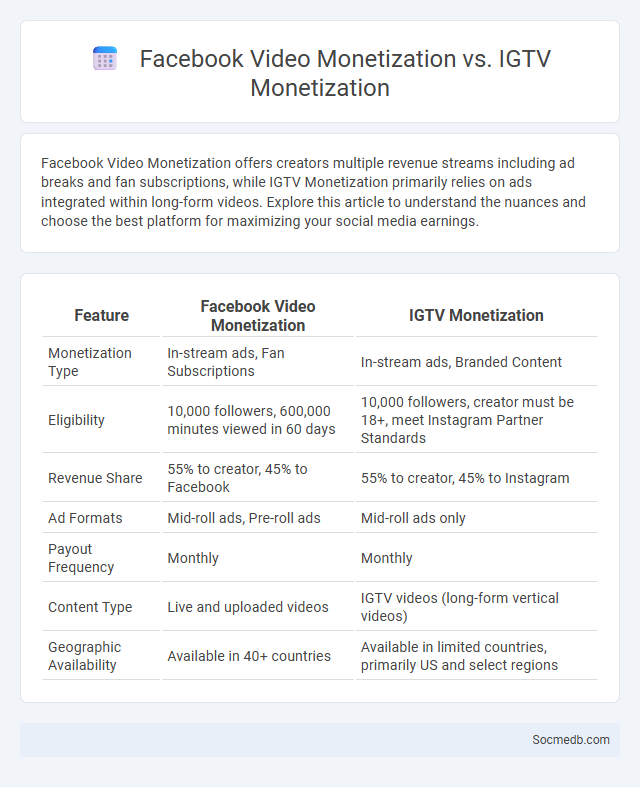
Photo illustration: Facebook Video Monetization vs IGTV Monetization
Facebook Video Monetization offers creators multiple revenue streams including ad breaks and fan subscriptions, while IGTV Monetization primarily relies on ads integrated within long-form videos. Explore this article to understand the nuances and choose the best platform for maximizing your social media earnings.
Table of Comparison
| Feature | Facebook Video Monetization | IGTV Monetization |
|---|---|---|
| Monetization Type | In-stream ads, Fan Subscriptions | In-stream ads, Branded Content |
| Eligibility | 10,000 followers, 600,000 minutes viewed in 60 days | 10,000 followers, creator must be 18+, meet Instagram Partner Standards |
| Revenue Share | 55% to creator, 45% to Facebook | 55% to creator, 45% to Instagram |
| Ad Formats | Mid-roll ads, Pre-roll ads | Mid-roll ads only |
| Payout Frequency | Monthly | Monthly |
| Content Type | Live and uploaded videos | IGTV videos (long-form vertical videos) |
| Geographic Availability | Available in 40+ countries | Available in limited countries, primarily US and select regions |
Overview of Video Monetization on Social Platforms
Video monetization on social platforms leverages multiple revenue streams, including ad placements, sponsored content, and direct fan contributions such as tipping or subscriptions. Platforms like YouTube, TikTok, and Facebook utilize algorithms to optimize content reach and maximize earnings through targeted advertising and engagement metrics. Emerging features such as live shopping and branded content collaborations further enhance creators' ability to generate income from video content.
What is Facebook Video Monetization?
Facebook Video Monetization enables creators to earn revenue by displaying ads within their video content on the platform. This feature includes in-stream ads such as pre-roll, mid-roll, and image ads, integrated seamlessly to enhance viewer engagement while generating income. Eligible pages must meet specific criteria, including follower count and video view thresholds, to access monetization tools and analytics.
IGTV Monetization Explained
IGTV monetization allows creators to earn revenue by featuring ads within their long-form videos on Instagram's IGTV platform. You can qualify for this monetization by meeting Instagram's eligibility criteria, including follower count and content guidelines, which helps increase your earning potential. Leveraging IGTV ads enhances your content strategy and diversifies your income streams through direct audience engagement.
Key Eligibility Requirements for Each Platform
Each social media platform enforces distinct key eligibility requirements to safeguard user integrity and compliance; for instance, Facebook mandates users to be at least 13 years old, while LinkedIn requires professional details and a real identity to foster networking authenticity. Instagram also sets a minimum age of 13 and encourages authentic content to maintain community standards. Twitter demands account verification and adherence to community guidelines, emphasizing safe and genuine interactions.
Revenue Models: Facebook vs IGTV
Facebook generates revenue primarily through targeted advertising, leveraging its extensive user data and diverse ad formats across its platform, including sponsored posts, video ads, and carousel ads. IGTV, as part of Instagram, focuses on video content monetization by integrating ads within long-form videos and offering branded content partnerships to creators, aiming to boost engagement and ad revenue on mobile devices. Understanding these revenue models helps You optimize marketing strategies for higher ROI through tailored ad placements on Facebook and IGTV.
Ad Formats and Placement Options
Social media platforms offer a variety of ad formats including photo ads, video ads, carousel ads, and sponsored stories designed to capture diverse audience attention. Placement options range from feeds, stories, reels, to in-stream videos, allowing precise targeting and optimal visibility across mobile and desktop devices. To maximize your campaign impact, select formats and placements that align with your marketing goals and audience behavior patterns.
Audience Reach and Engagement Comparison
Social media platforms like Facebook, Instagram, and TikTok offer varying audience reach and engagement levels, with TikTok leading in organic reach and video interaction rates surpassing 15%. Facebook remains dominant in total user base, exceeding 2.9 billion monthly active users, providing diverse targeting options ideal for broad audience scopes. Instagram excels in visual content engagement, boasting higher interaction rates among younger demographics, making it a preferred choice for brands targeting millennials and Gen Z.
Analytics and Performance Tracking
Social media analytics tools gather data on user engagement, reach, and demographics to provide insights into campaign effectiveness and audience behavior. Performance tracking metrics such as click-through rates, conversion rates, and sentiment analysis enable businesses to refine strategies for higher ROI. Leveraging platforms like Facebook Insights, Twitter Analytics, and Google Analytics helps optimize content distribution and measure real-time social media impact.
Creative and Content Guidelines for Monetization
Adhering to platform-specific creative and content guidelines is essential for successful social media monetization. Your content must align with community standards, avoid prohibited material, and meet quality benchmarks to qualify for monetization features like ads, sponsorships, and brand partnerships. Consistently engaging, original, and compliant content increases visibility and revenue potential across platforms such as YouTube, Instagram, and TikTok.
Choosing the Right Platform for Maximum Earnings
Selecting the right social media platform significantly impacts your earning potential by aligning your content with the audience demographic and engagement style unique to each site. Platforms like Instagram and TikTok excel in visual and short-form content, ideal for influencers and brands targeting younger demographics, while LinkedIn offers robust networking opportunities for professionals and B2B marketers seeking higher-value partnerships. Understanding user behavior and advertising algorithms on these platforms enables you to optimize content strategies and maximize revenue streams effectively.
 socmedb.com
socmedb.com